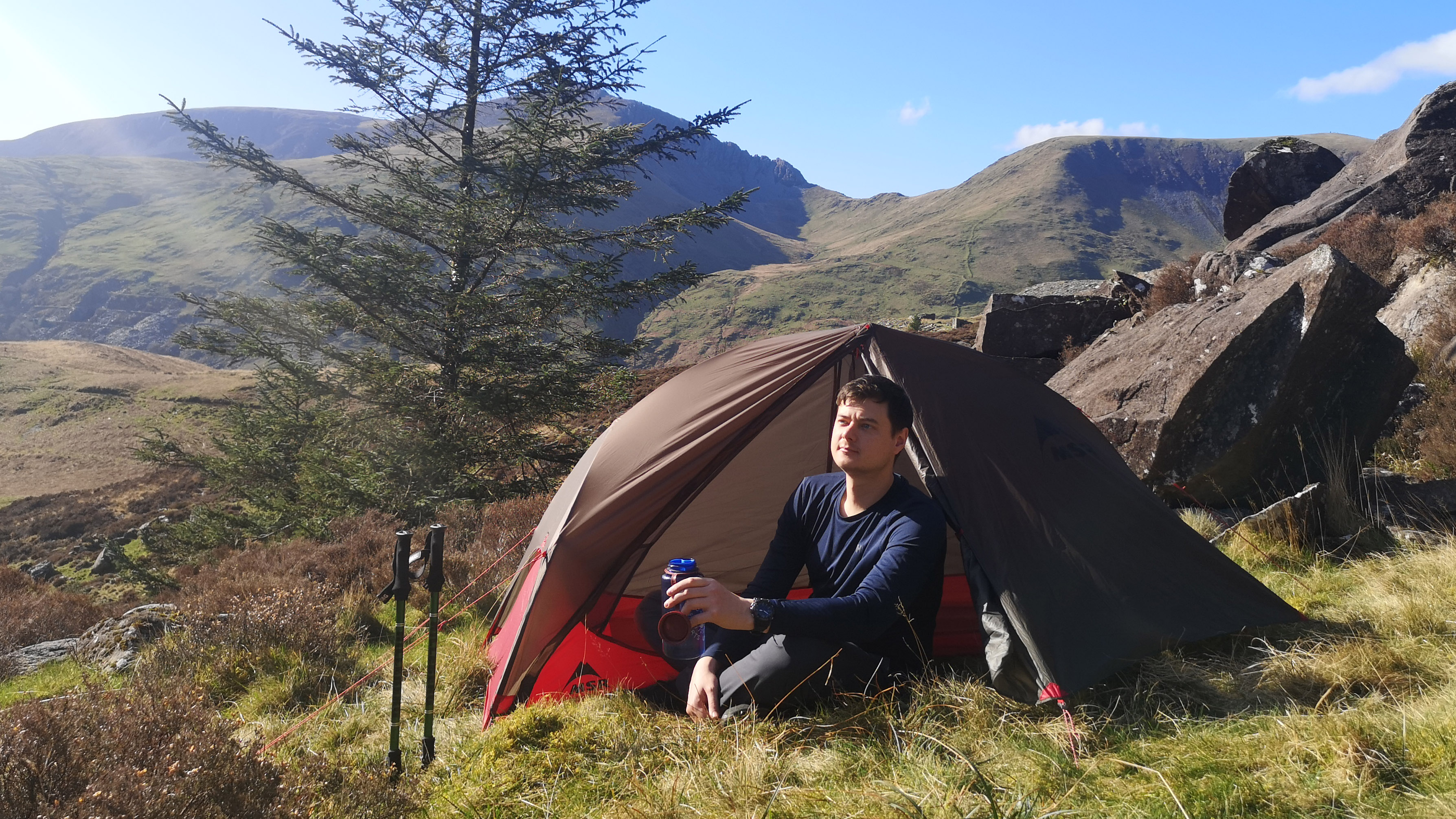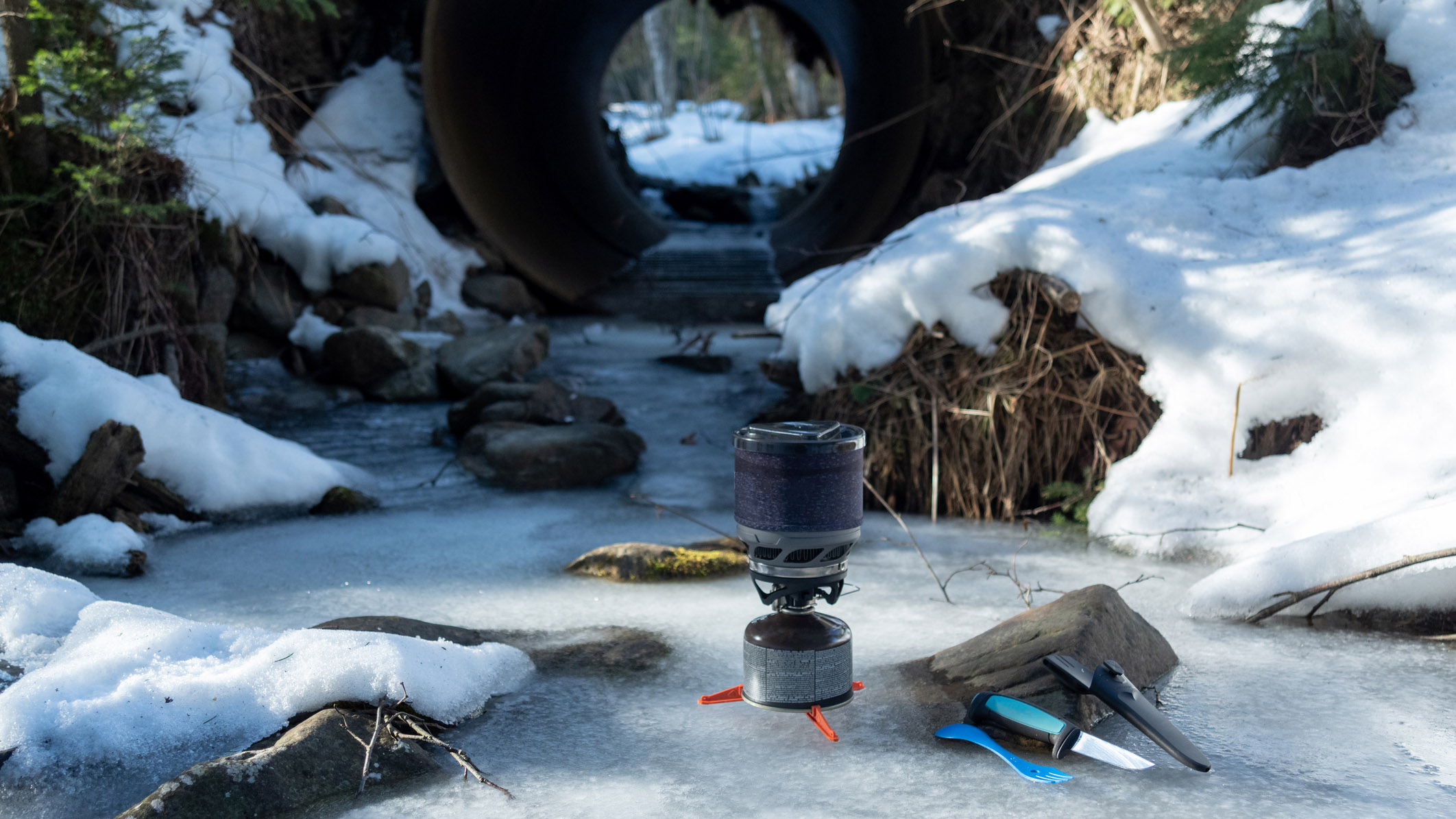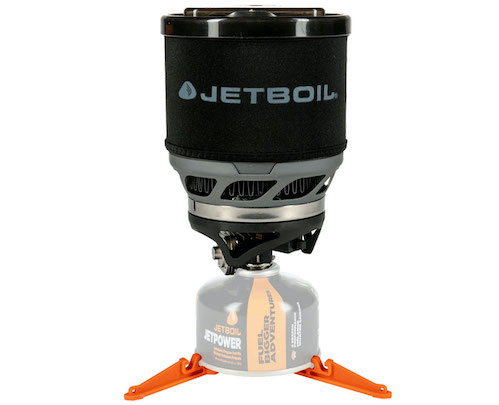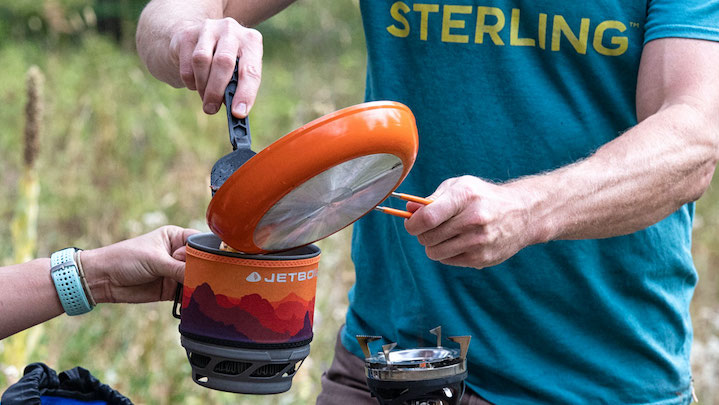Jetboil vs MSR WindBurner: it's hotting up in the battle of the fast boiling stoves
Jetboil vs MSR WindBurner: We ignite the battle between two of the best regarded all-in-one camping stoves – should you go for Jetboil's MiniMo or MSR's WindBurner?

We sent one of our camping experts into the wet, windy Welsh wilds to put two of the world's finest backpacking stove systems to the test. It's the battle of Jetboil vs MSR WindBurner. He compared the performance of Jetboil's excellent MiniMo with MSR's ever-popular WindBurner to see which best coped with the conditions, while also considering features like design, price and packability.
If you've made up your mind, we've rounded up the best deals on both stoves for you below. Otherwise, keep reading for the full lowdown on the Jetboil MiniMo and the MSR WindBurner below.
Jetboil MiniMo vs MSR WindBurner: the verdict
Our personal favourite is the Jetboil MiniMo, largely due to its more versatile design, thanks to a wider pot and better simmer control that makes cooking on the trail a little easier. However, picking an overall winner from these two superb stoves is a difficult task. They're both great options when it comes to choosing a camping stove.
If you’re planning a backpacking adventure and looking for a compact all-in-one system that will simply boil water quickly and consistently in varied conditions, we’d opt for the Windburner – which is also slightly cheaper (depending on where you are). It’s more packable and neatly stows a 100g canister in the top of the burner pot.
For our money, the WindBurner is also a better pick for that sort of use than Jetboil’s direct rival, the Flash, which has even faster boil times but is far more susceptible to windy conditions, which greatly detracts from its fuel efficiency. The Flash also has an unwieldy, flimsy handle and a delicate Piezo ignition system that is prone to breakage (a common symptom of all Jetboil stoves, in our experience).
| Header Cell - Column 0 | Jetboil MiniMo | MSR WindBurner |
|---|---|---|
| Price | $169.99 / £184.99 | $189.95 / £159.99 |
| Design | Neat and stylish, consists of a 1-liter burner pot with a heat exchanger at the base. This is protected in transit by an integrated plastic cup, which slots onto the bottom of the pot. | Neat and tidy, with a burner pot that is slimmer and taller than the MiniMo but has the exact same capacity. It has a heat exchanger style base that is more enclosed than the Jetboil design. |
| Features | More versatile, with a slightly larger practical capacity and a wider pot that makes cooking easier, plus improved simmer control. | MSR has thought of a couple of great features that are lacking in the Jetboil design, such as better graduated measurements on the inside of the burner pot, and the longer flame adjustment handle for improved safety in operation. |
| Performance | 1:59 minutes to boil 500ml (17.6 fl oz) of water | 2:16 minutes to boil 500ml (17.6 fl oz) of water |
| Weight and pack size | 492g /147mm / 5.79in | 474g / 175mm / 6.89in |
Today's best deals
Meet the expert

An outdoors writer and editor, Matt Jones has been testing camping kit in the field for nearly a decade. Having worked for both the Ramblers and the Scouts, he knows one or two things about cooking up a meal in the backcountry. He loves all things adventure, particularly long-distance backpacking, wild camping and climbing mountains – especially in Wales.
The brands
- Jetboil has an extensive range of all-in-one cooking systems
- We think the MiniMo is the best of their range
- MSR's range is less extensive
The first thing to say is that Jetboil’s range of all-in-one cooking systems is very extensive, with a wide range of choices. There’s the Zip, the MicroMo, the very popular Flash, the MiniMo and the MicroMo. For us, however, when it comes to choosing an all-rounder that's perfect for stashing in your best hiking backpack on an expedition, the MiniMo is the pick of the bunch. This is because of the way it balances weight and pack size with boiling and cooking versatility.
This speedy boiler has a versatile deisgn, wider pot and better simmering control than the WindBurner. Plus, it'll have water bubbling away in just over two minutes, thanks to its FluxRing technology.
All the latest inspiration, tips and guides to help you plan your next Advnture!
MSR’s all-in-one stove range is rather more streamlined. Your choices are the Windburner, the Windburner Duo, or the Reactor. The latter is available in a number of sizes and is a tried-and-tested design that's optimized for high altitude and cold weather expeditions. It’s probably overkill for most campers and backpackers, however, which is why we’d look to the two Windburner options for the majority of users. The Duo comes with a large 1.8-liter pot that is a great option if cooking camping meals for two to three buddies. However, it's bulkier and heavier than the Windburner, which is a neat and slim personal cooking system that – at a push – will work for two people.
The WindBurner is surely one of the best camping stoves around, with its award-winning Reactor technology, and it's more portable too, stowing away into a neat 100g package.

Price
- MSR WindBurner slightly more expensive in the US but cheaper in the UK
- Deals often available on both
All-in-one or personal cooking systems are typically more expensive than simple ultralight backpacking stoves. On the other hand, bear in mind that the MiniMo and the Windburner are bundled with pretty much all you need to get out there. With modular systems, you’ll also need to buy a cooking pot and maybe a bowl too, not just a stove, which adds to the overall cost. Due to the closed-head burners and integrated pot designs, all-in-one cooking systems are also usually more efficient than most other stoves, meaning they’ll boil water and cook food more quickly, using less gas.
When it comes to recommended retail prices, the Jetboil MiniMo is priced at $169.99 (US) / £184.99 (UK). The MSR WindBurner is a bit cheaper in the UK (£159.99) but more in the US ($189.95). Shop around, however, and it is possible to pick them up for far less.

Design
- Superior materials and design in the MiniMo
- MiniMo boasts piezo ignition, though it can be unreliable
- WindBurner benefits from secure locking mechanism
- WindBurner is more compact when packed down
Jetboil’s neat and stylishly designed MiniMo consists of a 1-liter (33.8 fluid oz) burner pot with a patented ‘Fluxring’ heat exchanger at the base. This is protected in transit by an integrated plastic cup, which slots onto the bottom of the pot. The MiniMo’s burner head nestles neatly inside the pot and is supplied in a protective fabric pouch. You also get a folding pot support that enables the stove to be used with other cooking equipment in the Jetboil range and even with other camping utensils. There’s a translucent plastic lid with a pouring spout and a series of perforated holes that we found made it easy to drain pasta or noodles. The lid has a triangular holder that houses a gas canister stand, which will fit all common sizes of butane-isopropane fuel canisters. Unlike the Flash or the WindBurner, there isn’t quite enough room to nestle a canister inside the pot with the other components though.
We found that the MSR WindBurner is similarly neat and tidy, with a burner pot that is slimmer and taller than the MiniMo but has the exact same capacity. It has a heat exchanger style base that is more enclosed than the Jetboil design. There’s a measuring cup/bowl that, just like the MiniMo, slots onto the base of the pot. It’s made from a slightly more pliable plastic than the Jetboil version, which seems less brittle but is also thinner and more likely to deform. The burner head itself is considerably larger and heavier than the Jetboil. It has a longer flame adjustment, which enable us to keep our hands further away from the burner. On the other hand, it lacks Piezo ignition, so we needed an external source to light the stove (either a firesteel, lighter or matches).
Arguably, you’d likely be carrying one of these anyway – so it’s a minor negative, and in any case, our experience is that Jetboil’s Piezo system is so delicate that it invariably breaks after a month or two of use. The issue is that the tiny sparking filament inevitably gets brittle from prolonged exposure to heat and soon snaps.

The WindBurner is also supplied with a gas canister stand and a transparent plastic lid with pouring and draining spouts. It’s easier to see through than the MiniMo’s lid, which is great when you need to check whether your water has boiled. There’s no protective pouch for the burner head, though there is a small fabric swatch to protect the inner pot from scratches when everything is stowed away. One major plus is that a small (100g/3.5oz) canister fits inside the WindBurner.
When it comes to stability, we found that the squat design of the MiniMo makes it more sturdy than the taller WindBurner. The latter’s pot employs a similar twist-and-click system to attach it to the burner head but, we have to say, it's far quicker and easier to align than the MiniMo’s, as it has multiple locking notches whereas the Jetboil MiniMo has only two, so you need to line it up carefully.
Overall, though it’s a close-run thing, we prefer the design and build quality of the Jetboil, which seems to use slightly superior materials, though we do prefer the Windburner’s secure and easy to use locking mechanism when attaching the burner to the pot. The Jetboil’s burner head is also lighter and more compact yet has built-in Piezo ignition (although the Piezo design is a little problematic in the long-term). On the other hand, the fact that a small gas canister nestles inside the Windburner pot design makes for a very neat package.

Features
- MiniMo benefits from wider pot and better pot support
- Great simmer control on the MiniMo
- WindBurner has a longer flame adjustment handle
- Graduated measurements on burner pot better on WindBurner
The MiniMo’s burner pot has a neoprene sleeve for enhanced efficiency, which also does a nice job of protecting it from scratches and dings. Unlike the Flash, it lacks a color-change heat-indicator to tell you when your water has boiled, which is a downside. On the other hand, the MiniMo pot has a very sturdy folding handle. This is a major plus in our eyes. In fact, it’s a stand-out feature compared to the Flash in the Jetboil range, which has only a flimsy fabric handle. The MiniMo’s wide plastic measuring cup is graduated to 300ml (10 fl oz) and could also be used as a bowl if you were really looking to minimize weight.
The Windburner pot has a wider range of graduations, making it simple to measure out liquids. Externally, there’s a plastic and fabric sleeve with an integrated handle, but it’s trickier to use than the sturdier Jetboil design. Nor is the sleeve removable, which makes it awkward to clean the pot should your cooking water boil over. There’s a measuring cup/bowl that, just like the MiniMo, slots onto the base of the pot. This is graduated to 360ml (12 fl oz). It’s made from a slightly more pliable plastic than the Jetboil version, which seems less brittle but is also thinner and more likely to deform.

Both pots have a nominal 1-liter capacity, though in use the max fill line for the MSR Windburner is just over 600ml (20 fl oz), which is the maximum amount of water you can safely boil in one go. The Jetboil MiniMo is much the same, though the wider pot means you can fill it a little higher, but not much. The design is slightly bulkier but also more versatile, with a better sleeve and handle than the Windburner.
When it comes to simmer control, the MiniMo wins out over the Windburner. It has much more precise adjustment, making cooking much easier. Though it is possible to cook simple foods with the Windburner, it is really optimized for boiling water quickly rather than simmering.
Unlike Jetboil, MSR do not supply – or even manufacture – a pot stand for the Windburner. If you want to use it with cookware other than the supplied 1-liter vessel, you’ll need to select a Windburner-compatible pot or pan from the MSR range. This arguably makes it a little less versatile than the Jetboil.

Performance
- MiniMo 1:59 minutes to boil 500ml (17.6 fl oz) of water
- WindBurner 2:16 minutes to boil 500ml (17.6 fl oz) of water
- Real world testing in a strong breeze, both performed just as well as each other
Both the MiniMo and Windburner are well-known for their fast boil times, meaning you can brew up a coffee for your hiking flask in no time at all. On test, in no-wind conditions, we achieved the following results (using two new 100g Jetboil Jetpower and MSR Isopro gas canisters respectively):
In windier conditions, both stoves worked more effectively than a typical backpacking stove and pot combination (we compared them to a Snow Peak Giga Power 2.0 stove as a ‘control’). That said, of the two, the WindBurner’s almost fully enclosed design made it less susceptible to gusts of wind than the Jetboil. The flip side, of course, is that not being able to see the flame makes it a little tricky to cook on the MSR stove in terms of adjusting flame size and power.
When it comes to efficiency, we found the Jetboil MiniMo to be marginally better on gas consumption – having weighed both canisters before and after use and comparing the results.
Weight and pack size
- WindBurner is more portable and lighter
- You can leave the MiniMo’s optional pot support behind to save weight
All in, our test samples of the two stoves weighed in at 474g (1lb 0.7oz) for the MSR Windburner and 492g (1lb 0.8oz) for the Jetboil MiniMo. That with all the elements included with both stoves, though without the weight of a gas canister. So, the MSR stove is slightly lighter, although it has fewer components – no fabric pouch and no external pot support. If you don’t need to pack the MiniMo’s pot support, which weighs 35g (0.8oz), the Jetboil becomes the lighter option.
The MSR Windburner is the clear winner when it comes to overall pack size, with packed dimensions of 175mm/6.89in (height) by 100mm/3.9in (width). The Jetboil MiniMo is shorter but wider, with measured dimensions of 147mm/5.79in (h) by 107mm/4.21in (w) – though the MiniMo’s folding handles protrude beyond those dimensions slightly, making it even wider still. Though those differences are small, it makes the Windburner noticeably more packable, and easier to slide in a rucksack. You could even stow it in a side pouch if needed.

An outdoors writer and editor, Matt Jones has been testing kit in the field for nearly a decade. Having worked for both the Ramblers and the Scouts, he knows one or two things about walking and camping, and loves all things adventure, particularly long-distance backpacking, wild camping and climbing mountains – especially in Wales. He’s based in Snowdonia and last year thru-hiked the Cambrian Way, which runs for 298 miles from Cardiff to Conwy, with a total ascent of 73,700 feet – that’s nearly 2½ times the height of Everest. Follow Matt on Instagram and Twitter.

